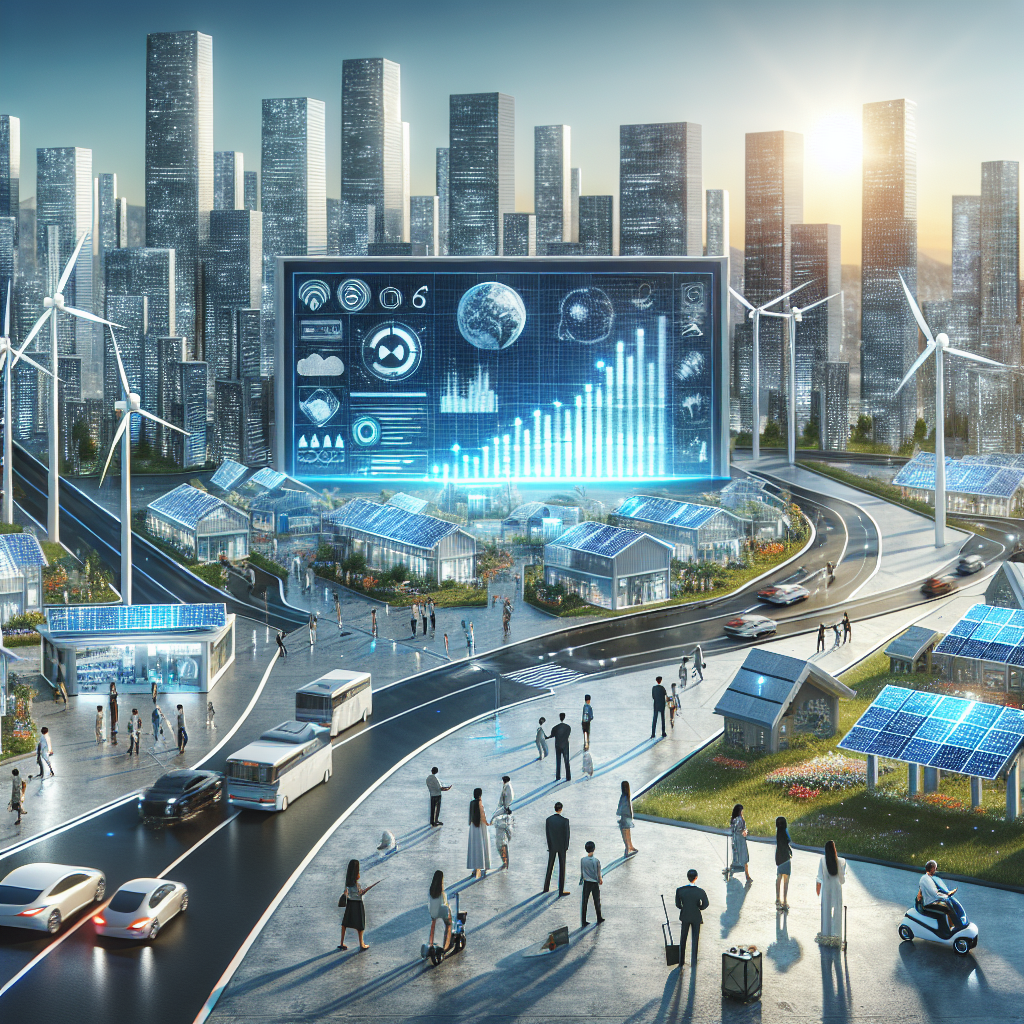-
Table of Contents
“Empowering Tomorrow: Shaping Sustainable Energy Policies Today”
Introduction

The future of renewable energy policy is poised to play a pivotal role in addressing the global challenges of climate change, energy security, and sustainable development. As the world transitions from fossil fuels to cleaner energy sources, governments, businesses, and communities are increasingly recognizing the need for robust and forward-thinking policies that support the deployment and integration of renewable energy technologies. These policies will be crucial in driving innovation, reducing greenhouse gas emissions, and ensuring equitable access to energy. By fostering a supportive regulatory environment, incentivizing investment, and promoting international cooperation, the future of renewable energy policy aims to create a resilient and sustainable energy landscape that benefits both people and the planet.
Innovations in Renewable Energy Policy: Shaping a Sustainable Future
As the world grapples with the pressing challenges of climate change, the future of renewable energy policy is becoming increasingly pivotal in shaping a sustainable future. Governments, businesses, and communities are recognizing the urgent need to transition from fossil fuels to cleaner, renewable energy sources. This shift is not only essential for reducing greenhouse gas emissions but also for ensuring energy security and fostering economic growth. Innovations in renewable energy policy are at the forefront of this transformation, driving significant changes in how energy is produced, distributed, and consumed.
One of the most promising developments in renewable energy policy is the implementation of feed-in tariffs (FITs). These policies guarantee a fixed, premium price for renewable energy producers, providing a stable and predictable revenue stream. By offering financial incentives, FITs encourage investment in renewable energy projects, from large-scale solar farms to small wind turbines. Countries like Germany and Spain have successfully utilized FITs to rapidly expand their renewable energy capacity, demonstrating the potential of such policies to drive substantial growth in the sector.
In addition to financial incentives, renewable energy policies are increasingly focusing on grid modernization. The integration of smart grid technologies is revolutionizing the way electricity is managed and distributed. Smart grids enable real-time monitoring and control of energy flows, enhancing the efficiency and reliability of the power system. By facilitating the integration of diverse renewable energy sources, such as solar, wind, and hydropower, smart grids help to balance supply and demand, reducing the need for fossil fuel-based backup power. This technological advancement is crucial for accommodating the intermittent nature of renewable energy and ensuring a stable energy supply.
Moreover, renewable energy policies are evolving to promote community-based energy projects. These initiatives empower local communities to generate and manage their own renewable energy, fostering a sense of ownership and participation. Community energy projects can take various forms, including cooperative solar installations, local wind farms, and shared energy storage systems. By decentralizing energy production, these projects enhance energy resilience and create economic opportunities at the local level. Countries like Denmark and Scotland have been pioneers in supporting community energy, demonstrating the social and economic benefits of such an approach.
Another key aspect of innovative renewable energy policy is the emphasis on research and development (R&D). Governments are increasingly investing in R&D to drive technological advancements and reduce the costs of renewable energy technologies. Breakthroughs in areas such as energy storage, advanced materials, and grid integration are essential for overcoming the current limitations of renewable energy. By fostering collaboration between academia, industry, and government, R&D initiatives are accelerating the transition to a sustainable energy future.
Furthermore, international cooperation is playing a vital role in shaping renewable energy policy. Climate change is a global challenge that requires collective action, and countries are increasingly working together to share knowledge, resources, and best practices. International agreements, such as the Paris Agreement, set ambitious targets for reducing greenhouse gas emissions and promoting renewable energy. Collaborative efforts, such as the International Solar Alliance and the Clean Energy Ministerial, are facilitating the exchange of expertise and driving global progress in renewable energy deployment.
In conclusion, the future of renewable energy policy is being shaped by a range of innovative approaches that are driving the transition to a sustainable energy system. From financial incentives and grid modernization to community-based projects and international cooperation, these policies are fostering the growth of renewable energy and addressing the urgent need to combat climate change. As the world continues to embrace renewable energy, the ongoing evolution of policy frameworks will be crucial in ensuring a sustainable and prosperous future for all.
The Role of Government in Advancing Renewable Energy Initiatives
The future of renewable energy policy is a topic of growing importance as the world grapples with the pressing need to combat climate change and transition to sustainable energy sources. Central to this transition is the role of government in advancing renewable energy initiatives. Governments around the globe are increasingly recognizing the critical part they play in fostering an environment conducive to the growth of renewable energy. Through a combination of regulatory frameworks, financial incentives, and public-private partnerships, governments can significantly influence the pace and scale of renewable energy adoption.
One of the primary ways governments can support renewable energy is through the implementation of robust regulatory frameworks. These frameworks can set clear targets for renewable energy adoption, establish standards for energy efficiency, and mandate the integration of renewable energy sources into national grids. For instance, many countries have adopted renewable portfolio standards (RPS) that require a certain percentage of electricity to come from renewable sources. Such policies not only provide a clear signal to the market but also create a level playing field for renewable energy technologies to compete with traditional fossil fuels.
In addition to regulatory measures, financial incentives play a crucial role in advancing renewable energy initiatives. Governments can offer subsidies, tax credits, and grants to reduce the financial burden on renewable energy projects. These incentives can make renewable energy more competitive with conventional energy sources, thereby encouraging investment and innovation in the sector. For example, the United States has implemented the Investment Tax Credit (ITC) and the Production Tax Credit (PTC), which have been instrumental in driving the growth of solar and wind energy, respectively. By lowering the cost of renewable energy projects, these financial incentives can accelerate the deployment of clean energy technologies.
Moreover, public-private partnerships are essential in scaling up renewable energy initiatives. Governments can collaborate with private sector companies to leverage their expertise, resources, and innovation capabilities. Such partnerships can facilitate the development of large-scale renewable energy projects, such as offshore wind farms and solar power plants. Additionally, governments can support research and development efforts by funding pilot projects and demonstration programs. These initiatives can help bridge the gap between emerging technologies and commercial viability, paving the way for widespread adoption.
Furthermore, governments can play a pivotal role in raising public awareness and fostering community engagement in renewable energy initiatives. By promoting the benefits of renewable energy, such as reduced greenhouse gas emissions, improved air quality, and job creation, governments can garner public support for clean energy policies. Educational campaigns and community outreach programs can empower citizens to participate in the transition to renewable energy, whether through adopting rooftop solar panels, supporting local wind projects, or advocating for sustainable energy policies.
In conclusion, the role of government in advancing renewable energy initiatives is multifaceted and indispensable. Through regulatory frameworks, financial incentives, public-private partnerships, and community engagement, governments can create an enabling environment for the growth of renewable energy. As the world moves towards a more sustainable future, the proactive involvement of governments will be crucial in ensuring that renewable energy becomes the cornerstone of our global energy system. By taking decisive action today, governments can help secure a cleaner, greener, and more resilient future for generations to come.
Global Trends in Renewable Energy Policy: Lessons and Predictions
As the world grapples with the pressing challenges of climate change, the future of renewable energy policy has become a focal point for governments, businesses, and communities alike. The global trends in renewable energy policy reveal a dynamic landscape where lessons from the past inform predictions for the future. This evolving narrative is not just about technological advancements but also about the strategic frameworks that guide the transition to a more sustainable energy system.
In recent years, countries around the world have made significant strides in adopting renewable energy policies. For instance, the European Union has set ambitious targets to achieve climate neutrality by 2050, with renewable energy playing a central role. Similarly, China, the world’s largest emitter of greenhouse gases, has committed to reaching peak carbon emissions by 2030 and achieving carbon neutrality by 2060. These commitments underscore a global recognition of the urgent need to shift away from fossil fuels.
One of the key lessons from these global trends is the importance of policy stability and long-term planning. Countries that have established clear, consistent, and long-term renewable energy policies have seen more significant investments and faster deployment of renewable technologies. Germany’s Energiewende, or energy transition, is a prime example. By setting long-term goals and providing stable policy support, Germany has become a leader in renewable energy, particularly in wind and solar power.
Moreover, the integration of renewable energy into national grids has highlighted the need for modernized infrastructure and smart grid technologies. As renewable energy sources like wind and solar are intermittent, ensuring a reliable energy supply requires advanced grid management and storage solutions. Countries like Denmark have excelled in this area, using sophisticated grid management systems to balance supply and demand effectively.
Another critical lesson is the role of financial incentives and market mechanisms in driving renewable energy adoption. Feed-in tariffs, tax credits, and renewable energy certificates have proven effective in various regions. For example, the United States’ Production Tax Credit (PTC) has been instrumental in the growth of the wind energy sector. By providing financial incentives, governments can lower the cost barriers and encourage private sector investment in renewable energy projects.
Looking ahead, the future of renewable energy policy will likely be shaped by several emerging trends. One such trend is the increasing decentralization of energy production. With advancements in technology, individuals and communities can now generate their own renewable energy through rooftop solar panels and small-scale wind turbines. This shift towards decentralized energy systems not only empowers consumers but also enhances energy security and resilience.
Additionally, the integration of digital technologies such as artificial intelligence and blockchain is poised to revolutionize the renewable energy sector. These technologies can optimize energy production, enhance grid management, and facilitate peer-to-peer energy trading. For instance, blockchain technology can enable transparent and secure transactions in decentralized energy markets, fostering greater trust and participation.
Furthermore, international cooperation and knowledge sharing will be crucial in accelerating the global transition to renewable energy. Collaborative initiatives like the International Solar Alliance and Mission Innovation bring together countries to share best practices, pool resources, and drive innovation. By working together, nations can overcome common challenges and achieve their renewable energy goals more efficiently.
In conclusion, the global trends in renewable energy policy offer valuable lessons and insights for the future. Stable policies, modernized infrastructure, financial incentives, and international cooperation are key components of a successful renewable energy strategy. As we move forward, embracing these lessons and adapting to emerging trends will be essential in creating a sustainable and resilient energy future for all.
Conclusion
The future of renewable energy policy is poised to be transformative, driven by technological advancements, increasing economic viability, and growing environmental imperatives. Governments worldwide are likely to implement more aggressive targets and supportive frameworks to accelerate the transition to clean energy. This will include enhanced subsidies, tax incentives, and regulatory measures to promote the adoption of solar, wind, and other renewable sources. Additionally, international cooperation and private sector investment will play crucial roles in scaling up renewable infrastructure and innovation. Overall, the trajectory of renewable energy policy suggests a significant shift towards sustainable energy systems, aiming to mitigate climate change and ensure energy security for future generations.





